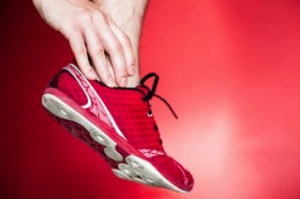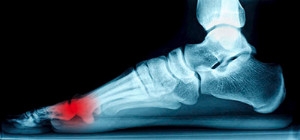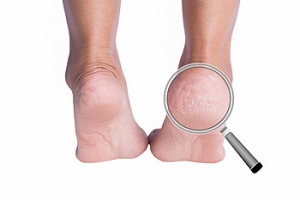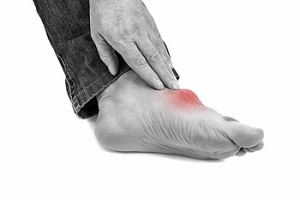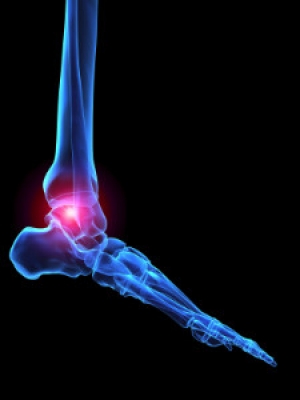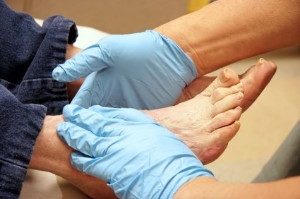Super User
How to Find the Best Running Shoes for You
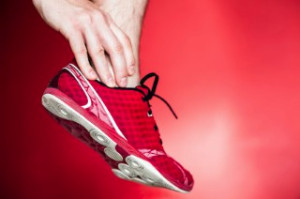 Proper footwear is important when you go for a run. To find the best running shoes for you, it is recommended that you visit a brick and mortar store. This way, you can try on shoes before you buy them and get expert advice and a proper shoe fitting from the store’s staff. To help you find the best pair of running shoes for your specific needs, look at a pair of your most frequently worn shoes for clues on how your foot functions, which can help them recommend a good shoe for you. Often, your running shoes may need to be larger than your everyday footwear. It is important to focus on the fit of the running shoe rather than the size. It is also suggested that you look for shoes that give your toes extra room, as the foot can swell throughout the day, especially while exercising. For more information on how to find the right running shoes for you, you can also consult with a podiatrist.
Proper footwear is important when you go for a run. To find the best running shoes for you, it is recommended that you visit a brick and mortar store. This way, you can try on shoes before you buy them and get expert advice and a proper shoe fitting from the store’s staff. To help you find the best pair of running shoes for your specific needs, look at a pair of your most frequently worn shoes for clues on how your foot functions, which can help them recommend a good shoe for you. Often, your running shoes may need to be larger than your everyday footwear. It is important to focus on the fit of the running shoe rather than the size. It is also suggested that you look for shoes that give your toes extra room, as the foot can swell throughout the day, especially while exercising. For more information on how to find the right running shoes for you, you can also consult with a podiatrist.
Finding a properly-fitting shoe is important in reducing injuries and preventing foot problems. For more information about treatment, contact Dr. Anna Petrov from Family Foot & Ankle Care. Our doctor will treat your foot and ankle needs.
Proper Shoe Fitting
A common concern when it comes to foot health, having properly fitted shoes can help prevent injuries to the foot. Out feet affect our posture and gait, which in turn affects the biomechanics and overall bodily structure. With 33 joints, 26 bones, and over 100 ligaments, the potential for serious injury is much greater than one realizes. Although the feet cease growth in adulthood, they still change shape as they mature. Here are some factors to consider when it comes to investing in proper fitting shoes:
- Be sure the shoes fit correctly right away
- Ensure the ball of your foot fits comfortably in the widest portion of the shoes
- Even though they may look fashionable, improper fitting shoes can either create adverse conditions or exacerbate existing ones you may already have
- Walk along a carpeted surface to ensure the shoes comfortably fit during normal activity
Keeping in mind how shoes fit the biomechanics of your body, properly-fitting shoes are vitally important. Fortunately, it is not difficult to acquire footwear that fits correctly. Be sure to wear shoes that support the overall structure of your body. Do your feet a favor and invest in several pairs of well-fitted shoes today.
If you have any questions please feel free to contact one of our offices located in Wheeling and Chicago, IL . We offer the newest diagnostic and treatment technologies for all your foot and ankle needs.
Read more about How to Get a Proper Shoe FitHow to Get a Proper Shoe Fit
Many people suffer from foot problems because their shoes are poorly fitted. When shopping for a new pair of shoes, fashion usually triumphs over comfortability. A pair of well fitted shoes is essential in preventing foot problems and potential injuries.
Poorly fitted shoes can cause foot issues such as plantar fasciitis, bunions, hammertoes, ingrown toenails, and foot pain. Shoes such as high heels and sandals may cause problems for your feet. These shoes put the foot in an unnatural position for long periods and fail to provide good foot support. It is recommended to not wear either one for an extended period.
When you are trying on shoes, make sure they have enough space for your toes to move around. Shoes shouldn’t be cramped but also shouldn’t have too much room that your foot moves around in them. A snug shoe is a good choice. They should also provide good arch support and cushioning. Athletic shoes tend to offer both good support and cushioning. A degree of flexibility is necessary so they aren’t too stiff or too unsupportive.
If you can wear your shoes for a long period of time without experiencing any discomfort, this is a sign that your shoes fit properly. Do not be too dismayed if the shoe isn’t a perfect fit at first; many shoes take a few days to weeks to properly break in. However don’t expect an uncomfortable shoe to become fitted to your foot.
For those with foot conditions such as flat feet or pronation, orthotics may be helpful or even necessary to prevent foot pain. Orthotics are inserts that are placed in the shoe and provide support and cushioning for the foot. While there are many types of orthotics out there, custom-made orthotics may be necessary depending upon your foot and foot conditions.
Feet change in size over time. It is important to check your foot size over time so that you can make sure you have the perfect fit for your feet. A podiatrist can provide more information on proper shoe fitting and foot orthotics.
What Are the Symptoms of Sesamoiditis?
 Sesamoiditis, a condition that affects the sesamoid bones, is a common cause of pain in the ball of the foot. It is typically a result of repeated injury and is especially common among dancers, joggers, people who have high arches, and people who frequently wear high heels. You may have sesamoiditis if you experience pain beneath the base of the big toe that is made worse by walking, and warmth, redness, or swelling near the big toe. A podiatrist can diagnose this condition after examining the foot. Sometimes, an X-ray or MRI is also used to rule out other potential causes of pain, such as arthritis, displacement, or a fracture of the sesamoid bone. For more information about this condition, consult with a podiatrist today.
Sesamoiditis, a condition that affects the sesamoid bones, is a common cause of pain in the ball of the foot. It is typically a result of repeated injury and is especially common among dancers, joggers, people who have high arches, and people who frequently wear high heels. You may have sesamoiditis if you experience pain beneath the base of the big toe that is made worse by walking, and warmth, redness, or swelling near the big toe. A podiatrist can diagnose this condition after examining the foot. Sometimes, an X-ray or MRI is also used to rule out other potential causes of pain, such as arthritis, displacement, or a fracture of the sesamoid bone. For more information about this condition, consult with a podiatrist today.
Sesamoiditis is an unpleasant foot condition characterized by pain in the balls of the feet. If you think you’re struggling with sesamoiditis, contact Dr. Anna Petrov of Family Foot & Ankle Care. Our doctor will treat your condition thoroughly and effectively.
Sesamoiditis
Sesamoiditis is a condition of the foot that affects the ball of the foot. It is more common in younger people than it is in older people. It can also occur with people who have begun a new exercise program, since their bodies are adjusting to the new physical regimen. Pain may also be caused by the inflammation of tendons surrounding the bones. It is important to seek treatment in its early stages because if you ignore the pain, this condition can lead to more serious problems such as severe irritation and bone fractures.
Causes of Sesamoiditis
- Sudden increase in activity
- Increase in physically strenuous movement without a proper warm up or build up
- Foot structure: those who have smaller, bonier feet or those with a high arch may be more susceptible
Treatment for sesamoiditis is non-invasive and simple. Doctors may recommend a strict rest period where the patient forgoes most physical activity. This will help give the patient time to heal their feet through limited activity. For serious cases, it is best to speak with your doctor to determine a treatment option that will help your specific needs.
If you have any questions please feel free to contact one of our offices located in Wheeling and Chicago, IL . We offer the newest diagnostic and treatment technologies for all your foot and ankle needs.
Types of Blisters and Dressings
 Research has shown that there are different types of blisters that can develop on the feet, consisting of deroofed, intact, or torn blisters. Blisters are defined as a small pocket of liquid that naturally forms over the damaged skin. When new skin has formed, the blister will gradually drain, and then disappear. Blisters generally develop as a result of excess friction, which can come from wearing shoes and socks that do not fit correctly. Proper healing is important, and this may be helpful in preventing an infection from occurring. It is beneficial to cover larger blisters with a dressing for protection. Island dressings are made with gauze in the center, and can be used for any type of blister. A blister plaster can protect the damaged area as it heals, and can provide an effective healing environment as a gel is emitted. Please consult with a podiatrist if you have frequent blisters on the feet. A podiatrist can guide you on how to properly manage and prevent blisters.
Research has shown that there are different types of blisters that can develop on the feet, consisting of deroofed, intact, or torn blisters. Blisters are defined as a small pocket of liquid that naturally forms over the damaged skin. When new skin has formed, the blister will gradually drain, and then disappear. Blisters generally develop as a result of excess friction, which can come from wearing shoes and socks that do not fit correctly. Proper healing is important, and this may be helpful in preventing an infection from occurring. It is beneficial to cover larger blisters with a dressing for protection. Island dressings are made with gauze in the center, and can be used for any type of blister. A blister plaster can protect the damaged area as it heals, and can provide an effective healing environment as a gel is emitted. Please consult with a podiatrist if you have frequent blisters on the feet. A podiatrist can guide you on how to properly manage and prevent blisters.
Blisters are prone to making everyday activities extremely uncomfortable. If your feet are hurting, contact Dr. Anna Petrov of Family Foot & Ankle Care. Our doctor can provide the care you need to keep you pain-free and on your feet.
Foot Blisters
Foot blisters develop as a result of constantly wearing tight or ill-fitting footwear. This happens due to the constant rubbing from the shoe, which can often lead to pain.
What Are Foot Blisters?
A foot blister is a small fluid-filled pocket that forms on the upper-most layer of the skin. Blisters are filled with clear fluid and can lead to blood drainage or pus if the area becomes infected.
How Do Blisters Form?
Blisters on the feet are often the result of constant friction of skin and material, usually by shoe rubbing. Walking in sandals, boots, or shoes that don’t fit properly for long periods of time can result in a blister. Having consistent foot moisture and humidity can easily lead to blister formation.
Prevention & Treatment
It is important to properly care for the affected area in order to prevent infection and ease the pain. Do not lance the blister and use a Band-Aid to provide pain relief. Also, be sure to keep your feet dry and wear proper fitting shoes. If you see blood or pus in a blister, seek assistance from a podiatrist.
If you have any questions, please feel free to contact one of our offices located in Wheeling and Chicago, IL . We offer the newest diagnostic and treatment technologies for all your foot care needs.
Read more about BlistersBlisters
Blisters are small pockets of fluid that occur on the top layers of the skin for several reasons. Friction, burns, and diseases are all known causes of blisters. Smaller blisters are known as vesicles, while larger blisters are referred to as bulla. The fluid inside the bubble can be blood, pus, or serum; which is a clear liquid that protects the skin. In most cases, blisters are not a major health issue, but they can be an indicator of a more serious condition.
Causes of blisters vary. Blisters are commonly caused by wearing poorly fitted shoes that rub against the foot. However, there are many other causes besides from friction; including burns, sunburn, insect bites, frostbite, poison ivy/oak, chemical exposure, impetigo, eczema, viral infections, and more.
Most blisters heal by themselves and do not require immediate medical care. If you have a blister, do not pop it since this may cause infection; it is advised to put a bandage over the blister to protect it. If the blister is large, causes pain, or if you have a fever, it is recommended that you see a doctor who can provide proper care. Blisters are easy to diagnose, and if considered prudent by the doctor, can easily be drained of fluid with a sterile needle as well.
To prevent blisters on the feet, wear shoes that fit properly and don’t cause rubbing. Socks can help prevent friction and it is recommended that you wear them if you are wearing shoes. Hand blisters can be avoided by wearing gloves during activities that cause friction against the hand. If you have a blister that pops, do not remove the dead skin, wash the area, apply antibiotic ointment, and cover with a bandage. It is okay in most cases to not seek immediate medical care for a blister if it was just caused by friction. However, if the blister causes pain or does not go away, it is suggested that you see a doctor for a diagnosis.
When to See a Doctor for Dry Heels
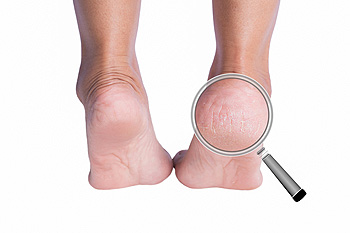 Dry, flaky heels can be uncomfortable and unsightly. Common causes of this condition are walking barefoot, taking hot showers, being on your feet for prolonged periods of time, wearing ill-fitting shoes, and not drinking enough water. Exfoliating and moisturizing your feet can be done at home and may provide some relief. However, in more severe cases, a visit to the podiatrist may be warranted. If you have painful dry heels or notice deep cracks, bleeding, or signs of infection, it is suggested that you see a podiatrist for treatment.
Dry, flaky heels can be uncomfortable and unsightly. Common causes of this condition are walking barefoot, taking hot showers, being on your feet for prolonged periods of time, wearing ill-fitting shoes, and not drinking enough water. Exfoliating and moisturizing your feet can be done at home and may provide some relief. However, in more severe cases, a visit to the podiatrist may be warranted. If you have painful dry heels or notice deep cracks, bleeding, or signs of infection, it is suggested that you see a podiatrist for treatment.
If the skin on your feet starts to crack, you may want to see a podiatrist to find treatment. If you have any concerns, contact Dr. Anna Petrov from Family Foot & Ankle Care. Our doctor can provide the care you need to keep you pain-free and on your feet.
Cracked Heels
It is important to moisturize your cracked heels in order to prevent pain, bleeding, and infection. The reason cracked heels form is because the skin on the foot is too dry to support the immense pressure placed on them. When the foot expands, the dry skin on the foot begins to split.
Ways to Help Heal Them
- Invest in a good foot cream
- Try Using Petroleum Jelly
- Ease up on Soaps
- Drink Plenty of Water
Ways to Prevent Cracked Heels
- Moisturize After Showering
- Skip a Shower
- Keep Shower Water Lukewarm
- Don’t Scrub Your Feet
If you are unsure how to proceed in treating cracked heels, seek guidance from a podiatrist. Your doctor will help you with any questions or information you may need.
If you have any questions, please feel free to contact one of our offices located in Wheeling and Chicago, IL . We offer the newest diagnostic and treatment technologies for all your foot care needs.
What Can Cause Gout?
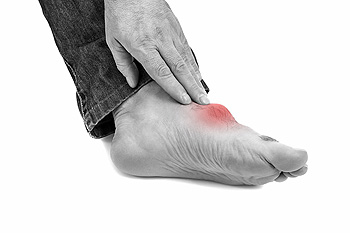 Gout is a type of arthritis that can cause sudden pain in the joints. The most commonly affected areas are the joints of the big toe. Gout is caused by a buildup of uric acid in the joints. While some people are more prone to developing gout due to genetics, environmental factors can also lead to the excess uric acid buildup that causes gout. Consuming foods that cause your body to produce large amounts of uric acid, for example, red meat, seafood, alcohol and sugary drinks, can increase your risk of developing gout. Some medications, such as aspirin, certain diuretics, and some blood pressure-lowering pills are also thought to cause gout. Gout is also associated with a variety of medical conditions, including diabetes, high blood pressure, joint trauma, obesity, infections, congestive heart failure, and kidney disease. If you suspect you may have gout, it is strongly suggested that you consult with a podiatrist, who can help you manage your condition and recommend strategies to prevent future gout flare-ups.
Gout is a type of arthritis that can cause sudden pain in the joints. The most commonly affected areas are the joints of the big toe. Gout is caused by a buildup of uric acid in the joints. While some people are more prone to developing gout due to genetics, environmental factors can also lead to the excess uric acid buildup that causes gout. Consuming foods that cause your body to produce large amounts of uric acid, for example, red meat, seafood, alcohol and sugary drinks, can increase your risk of developing gout. Some medications, such as aspirin, certain diuretics, and some blood pressure-lowering pills are also thought to cause gout. Gout is also associated with a variety of medical conditions, including diabetes, high blood pressure, joint trauma, obesity, infections, congestive heart failure, and kidney disease. If you suspect you may have gout, it is strongly suggested that you consult with a podiatrist, who can help you manage your condition and recommend strategies to prevent future gout flare-ups.
Gout is a painful condition that can be treated. If you are seeking treatment, contact Dr. Anna Petrov from Family Foot & Ankle Care. Our doctor will treat your foot and ankle needs.
What Is Gout?
Gout is a form of arthritis that is characterized by sudden, severe attacks of pain, redness, and tenderness in the joints. The condition usually affects the joint at the base of the big toe. A gout attack can occur at any random time, such as the middle of the night while you are asleep.
Symptoms
- Intense Joint Pain - Usually around the large joint of your big toe, and it most severe within the first four to twelve hours
- Lingering Discomfort - Joint discomfort may last from a few days to a few weeks
- Inflammation and Redness -Affected joints may become swollen, tender, warm and red
- Limited Range of Motion - May experience a decrease in joint mobility
Risk Factors
- Genetics - If family members have gout, you’re more likely to have it
- Medications - Diuretic medications can raise uric acid levels
- Gender/Age - Gout is more common in men until the age of 60. It is believed that estrogen protects women until that point
- Diet - Eating red meat and shellfish increases your risk
- Alcohol - Having more than two alcoholic drinks per day increases your risk
- Obesity - Obese people are at a higher risk for gout
Prior to visiting your podiatrist to receive treatment for gout, there are a few things you should do beforehand. If you have gout you should write down your symptoms--including when they started and how often you experience them, important medical information you may have, and any questions you may have. Writing down these three things will help your podiatrist in assessing your specific situation so that he or she may provide the best route of treatment for you.
If you have any questions, please feel free to contact one of our offices located in Wheeling and Chicago, IL . We offer the newest diagnostic and treatment technologies for all your foot care needs.
Signs of Rheumatoid Arthritis in the Feet
 Rheumatoid Arthritis (RA) is a type of arthritis in which the body’s immune system mistakenly attacks the body’s own joints. This causes inflammation in and around the joints, making the tissue lining in the joints thicken. While any joints in the body can be affected by RA, some of the most commonly affected ones are those located in the feet. Signs of RA in the feet include joint stiffness, soreness, pain, swelling, numbness, tingling, and a decreased range of motion. The severity of the symptoms may vary from day to day. RA is a chronic condition that requires medical management. If you have RA in your feet, a podiatrist can assist you in managing your pain levels, increasing your mobility, and improving your overall quality of life.
Rheumatoid Arthritis (RA) is a type of arthritis in which the body’s immune system mistakenly attacks the body’s own joints. This causes inflammation in and around the joints, making the tissue lining in the joints thicken. While any joints in the body can be affected by RA, some of the most commonly affected ones are those located in the feet. Signs of RA in the feet include joint stiffness, soreness, pain, swelling, numbness, tingling, and a decreased range of motion. The severity of the symptoms may vary from day to day. RA is a chronic condition that requires medical management. If you have RA in your feet, a podiatrist can assist you in managing your pain levels, increasing your mobility, and improving your overall quality of life.
Arthritis can be a difficult condition to live with. If you are seeking treatment, contact Dr. Anna Petrov from Family Foot & Ankle Care. Our doctor can provide the care you need to keep you pain-free and on your feet.
Arthritic Foot Care
Arthritis is a term that is commonly used to describe joint pain. The condition itself can occur to anyone of any age, race, or gender, and there are over 100 types of it. Nevertheless, arthritis is more commonly found in women compared to men, and it is also more prevalent in those who are overweight. The causes of arthritis vary depending on which type of arthritis you have. Osteoarthritis for example, is often caused by injury, while rheumatoid arthritis is caused by a misdirected immune system.
Symptoms
- Swelling
- Pain
- Stiffness
- Decreased Range of Motion
Arthritic symptoms range in severity, and they may come and go. Some symptoms stay the same for several years but could potentially get worse with time. Severe cases of arthritis can prevent its sufferers from performing daily activities and make walking difficult.
Risk Factors
- Occupation – Occupations requiring repetitive knee movements have been linked to osteoarthritis
- Obesity – Excess weight can contribute to osteoarthritis development
- Infection – Microbial agents can infect the joints and trigger arthritis
- Joint Injuries – Damage to joints may lead to osteoarthritis
- Age – Risk increases with age
- Gender –Most types are more common in women
- Genetics – Arthritis can be hereditary
If you suspect your arthritis is affecting your feet, it is crucial that you see a podiatrist immediately. Your doctor will be able to address your specific case and help you decide which treatment method is best for you.
If you have any questions, please feel free to contact one of our offices located in Wheeling and Chicago, IL . We offer the newest diagnostic and treatment technologies for all your foot care needs.
What is “Runner’s Toe?”
 "Runner’s toe" is a nickname for subungual hematoma. A subungual hematoma may occur when there is a painful buildup of blood, or a “blood blister,” under the toenail. Because this injury is often caused by repetitive force to the nail, hematomas are common injuries for runners, dancers, and rock climbers. The primary symptom of a subungual hematoma is severe pain caused by pressure from the blood under the nail, and discoloration of the nail. While this condition is not considered to be serious, it can be very uncomfortable. If you are experiencing pain from a toe injury, it is important to consult with a podiatrist to manage the pain. A podiatrist can prescribe medicine, as well as put holes in the top of the nail, known as trephining, to alleviate pain.
"Runner’s toe" is a nickname for subungual hematoma. A subungual hematoma may occur when there is a painful buildup of blood, or a “blood blister,” under the toenail. Because this injury is often caused by repetitive force to the nail, hematomas are common injuries for runners, dancers, and rock climbers. The primary symptom of a subungual hematoma is severe pain caused by pressure from the blood under the nail, and discoloration of the nail. While this condition is not considered to be serious, it can be very uncomfortable. If you are experiencing pain from a toe injury, it is important to consult with a podiatrist to manage the pain. A podiatrist can prescribe medicine, as well as put holes in the top of the nail, known as trephining, to alleviate pain.
Sports related foot and ankle injuries require proper treatment before players can go back to their regular routines. For more information, contact Dr. Anna Petrov of Family Foot & Ankle Care. Our doctor can provide the care you need to keep you pain-free and on your feet.
Sports Related Foot and Ankle Injuries
Foot and ankle injuries are a common occurrence when it comes to athletes of any sport. While many athletes dismiss the initial aches and pains, the truth is that ignoring potential foot and ankle injuries can lead to serious problems. As athletes continue to place pressure and strain the area further, a mild injury can turn into something as serious as a rupture and may lead to a permanent disability. There are many factors that contribute to sports related foot and ankle injuries, which include failure to warm up properly, not providing support or wearing bad footwear. Common injuries and conditions athletes face, including:
- Plantar Fasciitis
- Plantar Fasciosis
- Achilles Tendinitis
- Achilles Tendon Rupture
- Ankle Sprains
Sports related injuries are commonly treated using the RICE method. This includes rest, applying ice to the injured area, compression and elevating the ankle. More serious sprains and injuries may require surgery, which could include arthroscopic and reconstructive surgery. Rehabilitation and therapy may also be required in order to get any recovering athlete to become fully functional again. Any unusual aches and pains an athlete sustains must be evaluated by a licensed, reputable medical professional.
If you have any questions please feel free to contact one of our offices located in Wheeling and Chicago, IL . We offer the newest diagnostic and treatment technologies for all your foot and ankle needs.
Read more about Sports Related Foot And Ankle InjuriesThe Importance of Daily Foot Checks in Diabetic Patients
 Elevated blood sugar levels may cause a condition that is known as diabetes. The feet can be affected in diabetic patients, so it is extremely important to regularly and thoroughly check the feet for cuts, wounds, or bruises. This condition can cause a loss of feeling in the feet due to damaged nerves, and foot ulcers may result from infected cuts that go unnoticed. It is beneficial to frequently trim the toenails, and perform daily foot checks. Some patients may find it difficult to see the bottom of their feet, and it may help to use a mirror. Comfort can be found when the correct shoes are worn, and this is an effective method of protecting the feet. If you have diabetes it is strongly recommended that you are under the care of a podiatrist who can help you manage this condition.
Elevated blood sugar levels may cause a condition that is known as diabetes. The feet can be affected in diabetic patients, so it is extremely important to regularly and thoroughly check the feet for cuts, wounds, or bruises. This condition can cause a loss of feeling in the feet due to damaged nerves, and foot ulcers may result from infected cuts that go unnoticed. It is beneficial to frequently trim the toenails, and perform daily foot checks. Some patients may find it difficult to see the bottom of their feet, and it may help to use a mirror. Comfort can be found when the correct shoes are worn, and this is an effective method of protecting the feet. If you have diabetes it is strongly recommended that you are under the care of a podiatrist who can help you manage this condition.
Diabetic foot care is important in preventing foot ailments such as ulcers. If you are suffering from diabetes or have any other concerns about your feet, contact Dr. Anna Petrov from Family Foot & Ankle Care. Our doctor can provide the care you need to keep you pain-free and on your feet.
Diabetic Foot Care
Diabetes affects millions of people every year. The condition can damage blood vessels in many parts of the body, especially the feet. Because of this, taking care of your feet is essential if you have diabetes, and having a podiatrist help monitor your foot health is highly recommended.
The Importance of Caring for Your Feet
- Routinely inspect your feet for bruises or sores.
- Wear socks that fit your feet comfortably.
- Wear comfortable shoes that provide adequate support.
Patients with diabetes should have their doctor monitor their blood levels, as blood sugar levels play such a huge role in diabetic care. Monitoring these levels on a regular basis is highly advised.
It is always best to inform your healthcare professional of any concerns you may have regarding your feet, especially for diabetic patients. Early treatment and routine foot examinations are keys to maintaining proper health, especially because severe complications can arise if proper treatment is not applied.
If you have any questions please feel free to contact one of our offices located in Wheeling and Chicago, IL . We offer the newest diagnostic and treatment technologies for all your foot and ankle needs.



